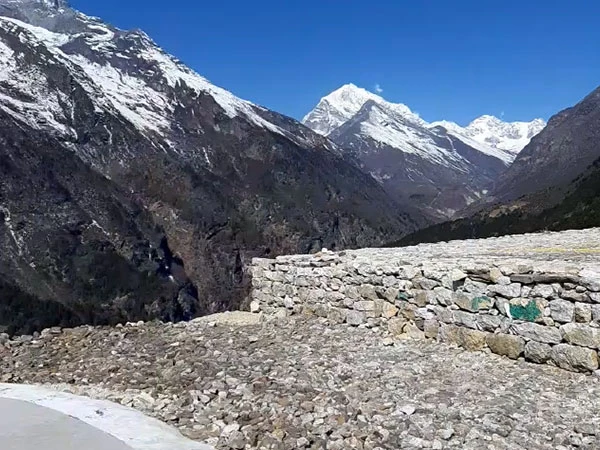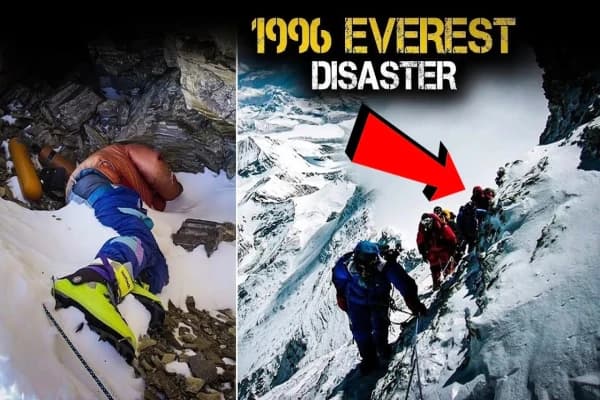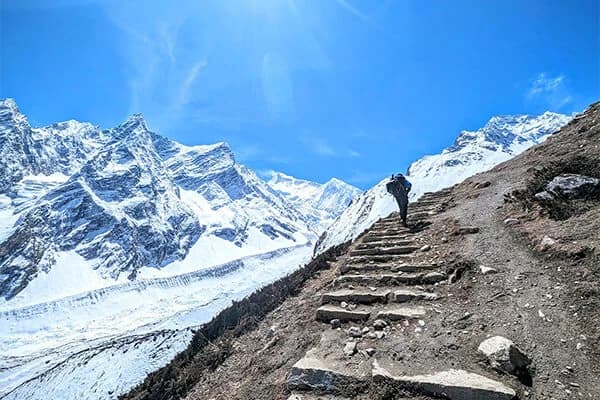Who is Rob Hall?
Robert Edwin Hall was a mountaineering guide born on 14th January 1961, Christchurch, New Zealand—died on 11th May 1996, Mount Everest, Nepal. He was the co-founder of Adventure Consultants, which was a company that pioneered commercial guiding on Mount Everest. During his journey as a mountaineering guide and an entrepreneur, he was able to make five successful ascents of the world's highest peak, Mount Everest. Hall met his end during a descent and was found later on 23rd May by mountaineers from the IMAX Expedition.
Rob’s tragic story isn't as known in the trekker community as much as it should have been. Climbing Mount Everest is a wish for many trekkers, which is something Hall had done many times. His final ascent to the peak is forever alive in history, books and movies. Despite his significant experience and several successful ascents, he unfortunately died in the tragic 1996 Everest disaster.
His story of high-altitude mountain climbing reflects how courageous and passionate he was about the daring mountain expeditions. Hall was the only non-Sherpa mountaineer able to complete his fifth ascent to the summit of Everest.
Why is he remembered in Mountaineering history?
Rob Hall is remembered for his tragic death during the 1969 Everest disaster, which took eight other climbers’ lives during a storm. His biography was chronicled in Jon Krakauer’s best-selling book named “Into Thin Air”.
Early Life and career of Rob Hall
Born on 14th Jan 1961, Christchurch, New Zealand, Rob developed a love for climbing at a very young age while growing up in the Southern Alps. Growing up, he was exposed to many mountain ranges in the southern region of New Zealand. Later, he worked as a watchmaker and earned his living. Soon enough, he realized that he had a passion for mountaineering and became a full-time mountaineer.
Rob earned two of the most prestigious awards, including the New Zealand Bravery Star (NZBS) and the Most Excellent Order of the British Empire (MBE). He was known for his determination and technical skills in the field.
In 1989, Rob met Gary Ball, and the friendship they had was unmatched. The duo grew close, as they both were passionate about mountaineering and decided to open a new company named Adventure Consultants as partners. Their partnership worked well, so they founded Hall and Ball Adventure Consultants in 1991.
Rob Hall’s Rise as a Mountaineer
The duo of Hall and Ball went on various expeditions and climbed the 7 summits together. They both were able to ascend all of the summits in 7 months. This set a world record at the time in 1990. After this remarkable achievement, Hall and Ball didn't want to continue being professional climbers and instead founded their company, i.e., Adventure Consultants.
After their successful seven summits, Ball and Hall became the talk of the Town in the mountaineering community, and every trekker wanted to hire them as their guide. In 1992, Rob and Gary conquered Everest with six clients, which became their crowning achievement of the company.
Hall gained recognition the following year for his exceptional Everest guiding services and other expeditions.
How did Rob Hall die?
May 11th, 1996, the tragic death of Rob Hall remains one of the saddest stories to have existed in the history of Everest mountaineering. An experienced climber and guide like him perished when he was caught in the deadly combination of extreme weather, delays, physical strains and high altitude conditions.
The 1996 Everest disaster, a fatal blizzard on the mountain, caused 14 mountain climbers to perish on the mountain, and 8 of them died due to this unfathomable natural disaster.
On the day of the summit on May 10th, 1996, Rob successfully rescued his client Doug Hansen from the summit; however, the first delay occurred during the descent. The clients were physically exhausted, fatigued and weak, barely holding on and struggling to continue. The rescued client was going to give up until Rob decided to help complete the journey. This was a personal decision on behalf of Rob, but he decided to portray it as a guide’s duty.
Due to this, they couldn't make it to the base camp in time and were already late in the day, which was past the scheduled time for the rest of the climbers. At the Foothills of the mountain came a violent, roaring, and frozen blizzard, surrounding the ground with a misery of ice and snow. The visibility worsened severely due to the storm, and navigation was nearly impossible at that moment.
After that drastic change in the Death Zone at an altitude of around 8,700 m, Hall and his client Hansen perished in the scary, dark, and cold region with extremely low oxygen levels.
What were the final words of Rob Hall?
After he became trapped and unable to descend due to extreme cold and exhaustion, he made his famous satellite radio call with his wife, Jan Arnold, who was pregnant at the time. This is what made the death of Rob Hall one of the most emotional moments in mountaineering history.
Rob’s final words were to his wife, “Don’t worry too much. Get a good sleep, my darling. Please don't worry too much”. At the time, he was 35 years old. Shortly after, Hall succumbed to the extreme conditions. Now his body rests on the mountain forever, near the South Summit, and is frozen in the air, solidified as the frozen soldier in the spooky atmosphere of Everest.
The 1996 Everest Disaster
The 11th May 1996 was truly an unfortunate event that claimed many lives on Everest. Due to this tragedy, many climbers lost their lives, i.e., 8 climbers among the deceased were Rob Hall and Scott Fischer, the head of Mountain Madness, including the Sleeping Beauty of Everest, which is another heartbreaking story on its own.
During an Everest expedition, every small action counts. But this time, it wasn't just a mistake. Instead, it was a whole series of tragic events and miscalculations. Several things lead to the 1996 Everest disaster, some of those catalysts are:
- Late in the summit attempt, Rob and other climbers began their descent after 2 P.M., which is a big no in Everest climbing culture.
- Unfixed ropes caused massive traffic at Hillary Step and exposed the climbers to harsh elements, and decreased their oxygen supplies.
- Overcrowding on the mountain due to attempts from multiple teams to reach the summit, and a lack of coordination, led to an unmanaged crowd.
- Unpredictable weather, a blizzard struck Everest during their descent, and the storm led the temperature to drop to freezing level. It deteriorated the visibility to almost zero.
- Physical exhaustion and altitude sickness, The body begins to deteriorate at elevations above 8,000 m, which makes even minor movements very intense.
- Dependent on the guide,it was clear that clients in the expedition lacked high-altitude climbing experience and overly relied on the guide, i.e., Rob Hall.
Is the body of Rob Hall still on Everest?
Yes. The dead body of Rob Hall is still lying on Mount Everest buried near the south summit at the foot of the Ridge or at the summit where he died in the harsh weather conditions and natural climates of 11th May 1996.
His body was impossible to retrieve due to Everest's altitude, low temperature and topographic nature. Generally, it is considered extremely challenging and most likely impossible to evacuate the deceased from Everest, as it puts more lives at risk during the process.
In the death zone, Rob’s body is preserved in a way as all the other people who died in the death zone at more than 8,000 m high altitude. The death zone is highly life-threatening, and the survival of the climbers highly depends on the exposure to the area, which also makes rescue missions deadly to the rescue unit.
Therefore, those fallen climbers on Everest lie on the slopes forever, being one with the Rainbow Valley of Mount Everest. The Climbers can see the impression of Rob Hall's body as they make their way up to the summit through the South Summit, which reminds them of the contrasts between the courage & bravery of humans and the might of Mother Nature.
What Happened to Rob Hall’s Wife?
During the death of Rob Hall, his wife, Jan Arnold, was in the last stage of pregnancy with their unborn child. She was worried about whether Rob was safe or if he could make it back alive when he was on the expedition.
Despite having severe distress and worry about the situation, while going through pregnancy and then eventually finding out about the tragic death of her husband, she took it ruthlessly and continued on Rob's unfinished business. She gave birth to their daughter named Sarah Hall, who never got to meet her father.
Jan would have been together with her husband on the Everest in 1996 expedition if it weren't for her pregnancy. They first met during Rob’s Everest expedition in 1990 as he attempted to summit Everest, and ever since then, the couple has bonded through scaling mountains. It was a bittersweet moment for Jan after Rob’s death, and she had to say goodbye to him in the same place where they first met.
Arnold was a mountaineering expert herself, so she was well aware of the life-threatening risks of scaling Mount Everest. She brought a significant service to several of Rob's life commemoration events and has been open about the emotional roller coaster she went through because of the 1996 Everest disaster.
Later, she became one of the most influential writers in the world of mountaineering history and gave continuity to her climbing career and support of the community.
What Happened to Rob Hall's Daughter?
Sarah Arnold-Hall was named after the final words of her father to his mom, and now Sarah works as an influencer and a goal coach to earn her living. She was born at the end of Hall’s life in 1996, out of his days on top of the world.
Just like her parents, she was climbing Mount Everest from a young age. Sarah resembles her father and has a knack for entrepreneurship, just like Hall. She became a certified High-performance coach in 2018 and graduated from Victoria University of Wellington. She gained significant fame after the release of the movie “Everest,” which was about her father's heartbreaking yet remarkable final expedition.
Rob’s daughter has stated that she feels more connected to her late father as an entrepreneur. She got her bastard's degree in Psychology and Philosophy.
Adventure consultants team members in the 1996 Everest expedition disaster
Rob Hall (Guide and Leader)
Robert Edwin Hall was the expedition leader and an export Mountaineer of the Adventure Consultants team. He had climbed Everest five times and was one of the world’s best and most experienced climbers. Which is why the climbers believed in his leadership.
Analyzing what happened, Hall died when he rescued his client despite the life-threatening challenges. Rob Hall passed away on May 11.
Doug Hansen (Client)
Hansen was an American repeated customer of Rob Hall who summited Everest. He made an attempt to summit Everest in 1995 but failed. He wanted to reach the summit successfully in 1996 but unfortunately he suffered from severe fatigue during freefall and resulted in landing unconscious in front of the South Summit of the bottom.
However Hall refused to give up on him which led him, Doug, along with another client, to die during the descent on May 10 due to adverse weather conditions.
Andy Harris (Guide)
Andy was a New Zealand guide and assistant from Adventure Consultants, part of Rob Hall's party, who made a decisive contribution to the expedition. Many think he died during the descent. Harris perished helping other climbers, his commitment to rescuing others epitomized the self-sacrifice of extreme mountain climbers in life and death situations.
The main cause of his death was hypoxia and hyperthermal conditions. He died at the top of the mountain and the body was never found after the disaster.
Jon Krakauer (Client)
Jon is an American Journalist and writer, a client of Adventure Consultants who participated in the 1996 Everest expedition. His main reason to go up the mountain was to tell a story to an outside magazine about the commercialization of Everest climbs in the tourism industry.
He was able to summit Everest and survived the storm and later wrote the New York Times best-selling “Into Thin Air” which tells about everything that happened during the unfortunate disaster. Jon survived the event due to his earlier summit and descent to Camp. His blog post initiated international media discussion about the risks of high-altitude trekking.
Yasuko Namba (Client)
Yasuko was the second Japanese woman to summit Everest and was a client of Adventure Consultants. She became the oldest female to conquer Everest on May 19th, 2017. Nambe later died during the descent when she was no longer able to progress forward. She couldn’t survive due to hypothermia and exhaustion after she and others were entombed by a blizzard.
Michael Mike Groom (Guide)
A guide from Australia with Adventure Consultants. Mike had summited Everest without the use of supplemental oxygen. He was lucky to survive the tragic event. Later, he won the Medal of the Order of Australia for his contribution to the mountaineering community.
Beck Weathers (Client)
Beck was an American client who remained dead in a blizzard. When the weather regained consciousness later, she was able to walk back to camp with severe frostbite but she survived.
Stuart Hutchison (Client)
Hutchison was a Canadian client who was one of the lucky ones to survive the disaster. Stuart was a doctor and a mountaineer. Also he was the youngest among them of the 1996 Adventure Consultant team.
Frank Fischbeck (Client)
Frank, an American client, like Hutchison, also survived the 1996 Everest Disaster. Fischbeck made the call to return before reaching the summit. He was part of the group that turned back in time before the blizzard hit, one of the lucky ones.
Lou Kasischke (Client)
Like Fischeck, Lao was also an American client, and he also survived the disaster. Lou, John, and Hutchison decided to turn back to the base. They realized reaching the turnaround time was impossible. So, they decided to not take the risk and the group returned before the summit.
John Taske (Client)
John was a former Australian army officer, a doctor, and a client of Adventure Consultants who survived the tragic event. Taske turned back before reaching the summit with Lou Kasischke and Stuart Hutchison after analyzing the situation and risks during the climb.
Helen Wilton
Helen was a New Zealand staff of Adventure Consultants and also the Base Camp manager. She survived the 1996 Everest Disaster because she stayed at the base camp. If Hele wasn't at the base camp, the rescue effort would not have reached the scene.
Legacy of Rob Hall
- After the death of Rob Hall, there were many debates regarding the ethics of commercial guiding on Everest, which brought some necessary changes in the operating process. His experience and contribution to the mountaineering community are still essential in today's context.
- After 1996, his company, Adventure Consultants, was continued under different leadership and followed his legacy.
- A film named “Everest” was made inspired by his life and contribution, which was portrayed by an actor called Jason Clarke.
- He has been a role model for the trekking community and will always be remembered as a dedicated guide who prioritized clients' lives over his own despite his conditions.
- His body remains on the slope of Everest, serving as a memorial to fellow climbers and representing human passion, bravery and courage.
FAQs About Rob Hall
Was Rob Hall ever found?
His body was found on 23rd May by mountaineers from the IMAX Expedition and yet it still remains just below the South Summit.
How many times did Rob Hall Summit Everest?
Rob summited Mount Everest 5 times but couldn't make it back safely after successfully reaching the summit for the 5th time in his life.
What were Rob Hall’s last words?
“I love you. Sleep well, my sweetheart. Please don’t worry too much,” Hall said. Rob Hall died on May 11, 1996.
Why is Rob Hall so famous?
Rob Hall was a New Zealand mountaineering guide and entrepreneur who made five ascents of Earth's highest peak, Mount Everest.
Could Rob Hall be saved?
There were efforts made to recover him, but due to unpredictable weather, challenging terrain, and storms, it is extremely unlikely that anyone will be able to reach him in time.
How accurate is the Everest movie?
The movie Everest is regarded as fairly accurate regarding what happened to Rob Hall, according to the author of Dark Summit: The True Story of Everest's Most Controversial Seasons, Nick Heil.






